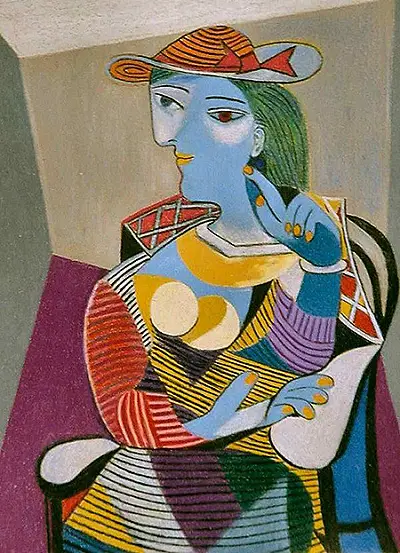The year that gave us Guernica, and all the study pieces for it, also provided several other significant artworks, including this one. Artist Picasso creates a sense of movement and depth in the painting through use of Cubist spatial techniques and tones of greens against reds. The intention was to draw the model closer to the foreground, and reduce focus on other elements of the work. There are similarities with his Harlequin series within this canvas, brightly colouring outfits to produce an atmosphere of fun and joviality. Many would argue that his muse appears as if a playing card figure, be it a King, Queen or Jack. The Cubist style adds to this, as well as the bright colours which are synonamous with traditional playing card design.
Black and white lines are used to contain areas of bright colour in clear sections, similar to how Piet Mondrian or Roy Lichtenstein would create their own modern art. Whilst they would produce abstract and cartoon styles themselves, the technique still worked with Picasso's cubist painting] of Seated Woman. The cubist form of this portrait helps to lift Marie-Therese projects from the canvas, creating depth to the work. Marie-Thérèse Walter was Picasso's mistress for around eight years and they shared one daughter together, Maya. It was his relationship with Dora Maar that eventually brought this close bond to a close.
Marie-Thérèse's youthful excurberance attracted Picasso and his portraits of her were typically bright and positive. This contrasts markedly with his Dora Maar portraits, such as Weeping Woman. Those were far more subdued and reflective. Le Rêve (1932) was an earlier painting by Picasso which captured a young blonde Marie, whilst Seated Woman came later in 1937 just as her role in Picasso's life was starting to dwindle. Picasso tended to move from one relationship to another with a fair amounnt of cross over - he was actually still married to his first wife, Olga Khokhlova, when he started dating Marie-Thérèse Walter.
In the portrait of Marie-Therese found here, the artist continues with the pose of Ingres Madame Moitesier. There is a restricted feel to the overall composition, almost caging the subject into the canvas. There is an interesting comparison to be made with Seated Dora Maar, when Picasso styles this model somewhat differently. For a period of time he would use both ladies for his work interchangeably, perhaps pointing to a confusion in his own mind as to whom he wanted to be with. Picasso's first wife only became aware of this affair when Marie had become pregnant. She lived just across the road, so they would have known each other. It was only a year after the birth of Maya that Picasso was to start seeing his new love, Dora Maar.

